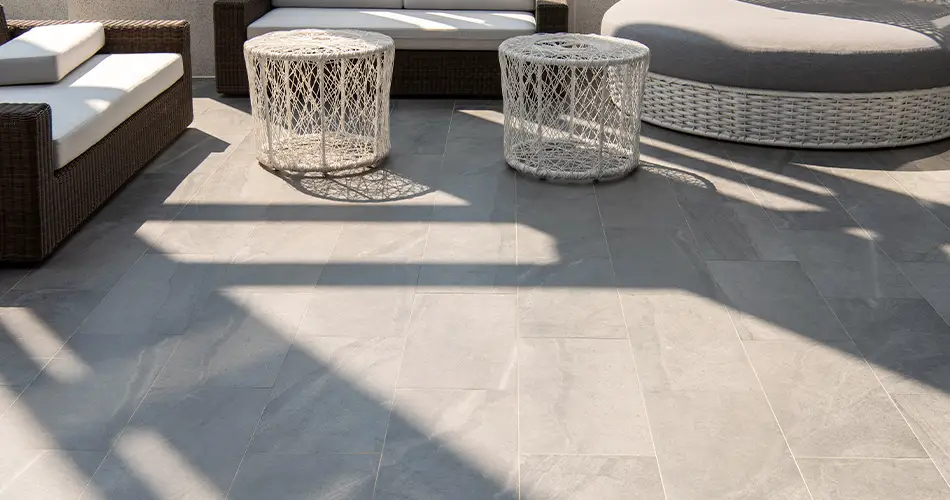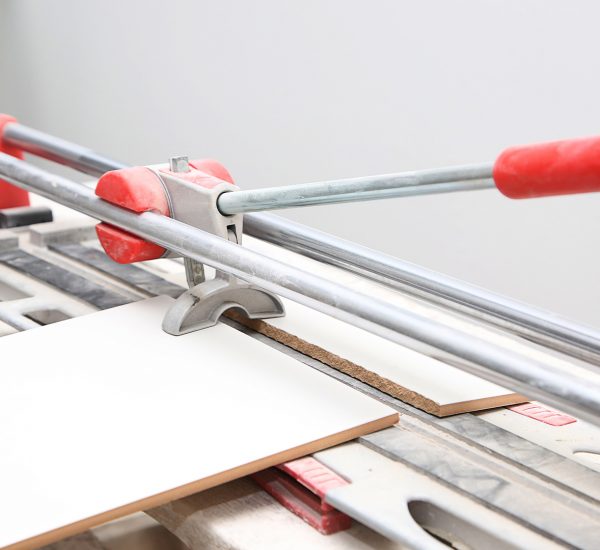Tiled bathrooms and kitchens have long been in style. And today, one of the fastest-growing design trends is to extend that classic aesthetic beyond the home and into the garden. Tile manufacturers are increasingly expanding their stunning ranges of outdoor-rated stone and porcelain, making it easy to create a tiled look practically anywhere. From tiled BBQ areas and outdoor kitchens to patios and exterior walls, tile works. It’s a great way to add warmth and character to your outdoor space.
However, just as you’d select tiles that are designed for outdoor use, you need to choose outdoor tile mortar, too. In fact, using the right adhesive and grout is essential for the success of your project.
First Things First: Do You Really Need Exterior Adhesive?
If you’re tiling a wall, then adhesive is an absolute must. After all, those tiles aren’t going to magically stick to a vertical surface. But if you’re tiling the floor, can’t you just stick tile straight onto the dirt?
The simple answer is yes. And there are definitely benefits to tiling directly onto dirt. Known as a ‘dry installation’ as there’s no need for adhesive, this method is very quick and easy. There’s no need to pay out for adhesive, and the tiles can be taken up or rearranged at any time with very little effort. Dirt, sand, and fine gravel all make for a good solid bed as long as you remove any larger debris.
However, a dry installation isn’t particularly long-lasting, and may not be very stable. The dirt underneath can move and shift over time, increasing the risk of an uneven floor or tile breakage. This is even more of a risk with thick 20cm porcelain slabs, which are heavy and more likely to cause shifting.
A more secure alternative is to first lay a concrete screed – a thin layer of concrete – over a weed-proof membrane. Then, you have a sturdier base upon which to lay your tile. If using this option, you’ll need to ensure you have an outdoor adhesive that’s specially designed for exterior use.
Can You Use Tile Grout And Adhesive Outside?
Tile adhesive and tile grout can both be used for outdoor applications, as long as the products are rated for exterior use. The most important factor is not to use any product that is labelled as being for indoor use only. These products often have very little – if any – water resistance. This means they won’t last very long when exposed to rain and other conditions. The best tile adhesive to use is a cement-based adhesive that’s suitable for exterior tiling, and a water-resistant outdoor grout.
It’s also possible to simply use cement. However, cement can often shrink as it dries, which runs the risk of a hollow void appearing underneath the tile. This can make the tile weaker, and it may crack or become loose over time as it’s walked on. In most cases, a cement-based adhesive will be best.
What Is Outdoor Tile Grout And Adhesive?
A specially formulated outdoor tile adhesive and grout will be designed to maintain high levels of performance, even under harsh weather conditions. These products will often be labelled as:
- Water resistant
- Frost resistant
- Temperature resistant
- Mould resistant
- Organic staining resistant
Outdoor adhesives will also have properties that ensure the product will adhere effectively to exterior materials such as cement, stone, and brick. This allows for an easier, fuss-free application.
You may notice that outdoor adhesives are marked as water resistant, but not waterproof. That’s OK. No cement-based adhesive will be 100% waterproof, and it doesn’t need to be. The tiles should form a good enough barrier to protect much of the adhesive from very high levels of moisture. The only difference would be when the tiles were expected to be fully submerged in water; for example, if you were tiling the bottom of a swimming pool. In this instance, it’s best to use an epoxy-based adhesive and grout. Alternatively, look for a product specifically designed for this type of wet application.
What To Look For In Outdoor Tiling Products
In addition to being weather resistant, it’s also important to use the same best practices as you would when selecting an indoor tile adhesive and grout. Some aspects to consider include:
Type Of Tile
The most popular types of tile for use outdoors are porcelain or natural stone. Until recently, ceramic wasn’t recommended for exterior applications as it’s quite porous and delicate. However, more and more manufacturers are starting to launch outdoor ceramic ranges. And so, with more options becoming available, it’s important to make sure you’re using products compatible with the material. For example, use an exterior adhesive for stone if using marble, slate, or granite tiles.
Format
Some people prefer the convenience of ready-mixed adhesives, while others prefer to use ready-to-mix alternatives. Both are fine ways of working. However, most outdoor tile adhesives come in powder form. These need to be mixed just prior to laying the tiles. This allows you to create the right consistency for your tile type, and gives you more control over coverage. However, there are a small number of pre-mixed outdoor adhesives on the market if you prefer to work in that way.
How To Use Outdoor Tile Mortar
The good news is that, if you’ve ever tiled inside, then you can tile outside. There’s very little difference between tiling an outdoor floor or wall and tiling an indoor floor or wall. Once the surface has been properly primed, simply apply the adhesive (ensuring good coverage) and place the tile into position. You can find out more about the process by reading our guide on how to tile a wall.
Adhesive must be left to dry completely before standing on the tiles, or beginning to grout. You can grout outdoor tiles in the same way as you’d grout indoor tiles. However, an extra step is necessary to ensure that the grout continues looking its best. While exterior grout is designed to withstand the elements, you can give it an extra boost by sealing the grout. You can do this once the grout has dried by using a grout sealant. This isn’t a mandatory step, but it can help your grout to last longer.
Tiling Products Are Only As Good As The Tiler
Selecting the right outdoor adhesive and grout is important. However, it’s even more important to remember that these products work best when best practices are followed. Knowing how to tile an exterior wall and floor in the best way possible can help ensure a project is completed successfully.
Helpful Tips:
Prime Surfaces
You should be able to tile straight on top of brick – assuming the wall is reasonably level, and that it’s strong enough to hold the weight of the tiles. However, for highly porous surfaces like cement screed, plaster, or rendering, it’s a good idea to prime the walls with an exterior primer.
Be Patient
Only begin to grout walls and floors once the adhesive is fully dried. Trying to rush the process can result in uneven tiling or voids underneath. A good rule of thumb is to wait 24 hours before grouting, but do check the manufacturer’s instructions on your products to ensure best results.
Tile In Good Weather
It probably goes without saying that the best conditions for outdoor tiling are dry and still. Heavy rains as you’re laying the tiles can dilute the adhesive, making it less effective. Similarly, strong winds can blow debris onto the surface to be tiled, resulting in a poorer and more uneven outcome.
Have The Right Tools For The Job
Of course, the most important tip is to ensure you have all the essential tools you need for tiling. At the very least, you should make sure you have a trowel for the adhesive, a grout float, buckets, water, and a tile sponge. You may also need spacers to keep a consistent, uniform gap between the tiles.




